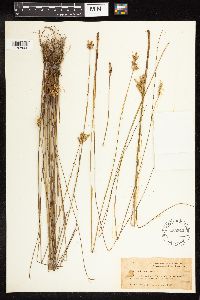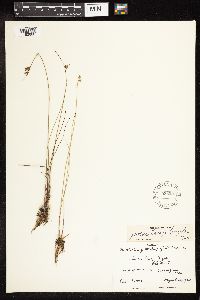Juncus vaseyi
|
|
|
|
Family: Juncaceae
Vasey's Rush
|
Herbs, perennial, tufted, 2--7 dm. Rhizomes densely branching. Culms 1--15(--25). Cataphylls 1--2(--3). . Leaves basal, (1--)2--3; auricles 0.2--0.4(--0.6) mm, scarious, rarely ± leathery; blade green, nearly terete, 10--30 cm x 0.5--1 mm, margins entire. Inflorescences terminal, 5--15(--30)-flowered, congested or not, 1--5 cm; primary bract usually much shorter than inflorescence. Flowers: bracteoles 2; tepals greenish to tan, lanceolate or widely so, 3.3--4.4 mm; outer and inner series nearly equal, apex acuminate; stamens 6, filaments 0.5--0.9 mm, anthers 0.4--0.8 mm; style 0.1--0.2 mm. Capsules golden tan or light brown, 3-locular, ellipsoid, (3.3--)3.8--4.7 x (1.1--)1.3--1.7 mm. Seeds tan, ellipsoid to lunate, body (0.52--)5.5--0.65(--0.7) mm, tails 0.2--0.5 mm. 2n = ca. 80. Flowering and fruiting summer--early fall. Permanently moist, usually exposed areas including wet meadows, raised sites or margins of bogs, or depressions along sandy lakeshores; 200--1500 m; Alta., B.C., Man., N.B., Nfld. and Labr. (Labr.), N.W.T., N.S., Ont., Que., Sask.; Colo., Idaho, Ill., Iowa, Maine, Mich., Minn., Mont., N.Dak., N.Y., S.Dak., Vt., Wis., Wyo. Perennial grasslike forb 20 - 70 cm tall Leaves: one to three, basal, green, 10 - 30 cm long, 0.5 - 1 mm wide, linear, grasslike, almost round in cross section, but lacking crosswise partitions inside (non-septate). The leaves also have a thin and papery (rarely even close to leathery), very short (0.2 - 0.6 mm), ear-like appendage (auricle) at the top of the leaf sheath. Inflorescence: a terminal, 1 - 5 cm long, often congested, branched structure with five to twenty, single, stalked, radially symmetric, small flowers terminating short branches. The entire branched inflorescence is subtended by a short bract (usually much shorter than full inflorescence), and the individual stalked flowers have two small bracts (bracteoles) positioned directly below the tepals. Stamens: six, with 0.5 - 0.9 mm long filaments, and slightly shorter anthers (0.4 - 0.8 mm). Pistil: with one superior ovary, a 0.1 - 0.2 mm long style, and three stigmas. Fruit: three-chambered, golden tan or light brown, 3.3 - 4.7 mm tall (slightly taller than tepals), 1.1 - 1.7 mm wide, ellipsoid, stalked capsules. Stems: tufted, erect, smooth, round in cross section, and arising from densely branched rhizomes. Seeds: many, tan, 0.52 - 0.7 mm long, ellipsoid to crescent-shaped, with narrowed, 0.2 - 0.5 mm long, clear tails at the ends. Tepals: six in two whorls of three, greenish to tan, 3.3 - 4.4 mm long, lance-shaped (or wider) with tapered, slender, pointed tips. Similar species: Juncus vaseyi is quite similar to J. greenei except that species has much darker and more blunt tepals and capsules, the basal bract is normally longer than the inflorescence, and the seeds never have long, clear tails. Also somewhat similar is J. interior since it has the inflorescence bract shorter than the inflorescence, and the tepals are similarly shaped and colored, but that species has flat leaves and never has tails on the seeds. Some members of the subgenus Septati may appear similar to J. vaseyi because they have tailed seeds and leaves that are round in cross section, but they also have distinct cross-partitions (septa) in the leaves, and the flowers are grouped in tight clusters or heads. The exception in that subgenus is J. pelocarpus because it has very obscure leaf septa and the flowers are single or in pairs, but that species does not have tailed seeds. Other species in the same subgenus as J. vaseyi differ by lacking tailed seeds, and either having much larger leaf sheath auricles or flat leaf blades. Flowering: summer to early fall Habitat and ecology: Very rare, only found a couple times in the Chicago Region, requiring permanently moist, usually exposed areas. Occurence in the Chicago region: native Notes: The type specimen of Juncus vaseyi was collected by George Vasey along the banks of the Fox River in Ringwood, Illinois (McHenry County). Author: The Field Museum Stems cespitose from a short rhizome, 3-8 dm; basal lvs very slender, terete or nearly so, to 3 cm; invol lf shorter than the infl or up to 5(-7) cm; infl obpyramidal, compact, 1-4 cm; fls prophyllate; tep lanceolate, acute or acuminate, appressed even at maturity, the sep 3.5-4.5 mm, the pet 3.2-4.2 mm; anthers 6, about equaling the filaments; fr trilocular, oblong-cylindric, 4.1-5.4 mm, truncate; seeds fusiform, becoming mucilaginous when wetted, the body 0.5-0.8 mm, each end with a slender pale appendage usually 0.2-0.4 mm; 2n=42. Moist, often sandy soil; N.S. to Sask. and B.C., s. to N.Y., Ind., Minn., and Colo. An apparent hybrid with no. 6 [Juncus tenuis Willd.], in Me., has been called J. دronensis Fernald. Gleason, Henry A. & Cronquist, Arthur J. 1991. Manual of vascular plants of northeastern United States and adjacent Canada. lxxv + 910 pp. ©The New York Botanical Garden. All rights reserved. Used by permission. From Flora of Indiana (1940) by Charles C. Deam Indiana Coefficient of Conservatism: C = 10 Wetland Indicator Status: FACW |



































































